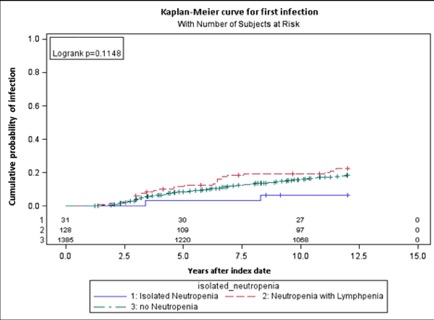Session Information
Date: Friday, November 6, 2020
Title: SLE – Diagnosis, Manifestations, & Outcomes Poster I: Clinical Manifestations
Session Type: Poster Session A
Session Time: 9:00AM-11:00AM
Background/Purpose: Leukopenia in SLE is defined as leukocyte count below 4,000/mm3 on two or more occasions according to the ACR criteria and may include a combination of lymphopenia and neutropenia or either of these alone. Neutropenia may be mild/moderate or severe and may be associated with increased susceptibility to infection. Our objective was to determine the prevalence and factors associated with isolated neutropenia in outpatients with SLE.
Methods: Retrospective analysis of prospectively collected data. Setting: Patients in our cohort are followed regularly at 2-6 months’ intervals according to a standardized research protocol which captures demographic, clinical, laboratory and therapeutic variables along with the major co-morbidities. All data are entered and stored in an electronic database. Neutropenia was defined as absolute neutrophil count (ANC) below 1,500/mm3. Mild/moderate neutropenia was defined as neutropenia ≥ 1000/mm3 and < 1500 /mm3) and severe neutropenia was a neutrophil count < 1000 / mm3. Patients with isolated neutropenia on at least 2 consecutive visits with gap between visits of ≤ 24 months were identified. The baseline characteristics of the patients were compared between patients who experienced isolated neutropenia and those with combined neutropenia and lymphopenia. The percent of infections and the rate of infection in the 2 groups was determined. Mean with standard deviation and median with interquartile ranges were used to describe continuous variables, counts with percentages were use to describe categorical variables, then variables were compared by Student’s t-test or Chi-Square test between groups.
Results: Of 2045 patients in the database, 170 (8.3%) were found to have neutropenia on 2 consecutive visits (visit gap ≤24 months) of whom, 30(1.4%) had severe neutropenia and the rest was mild to moderate. Isolated neutropenia was found in 35(1.9%) patients, 29 (82.9%) with mild moderate and 6 (17.1%) with severe neutropenia. Patients with isolated neutropenia and neutropenia with lymphopenia were similar except for Black ethnicity which was more common in isolated neutropenia and more patients taking azathioprine had neutropenia/lymphopenia (Table 1)
Infections occurred in 17,6% with no neutropenia, 6.5% with isolated neutropenia and 21.9% with neutropenia/lymphopenia. Kaplan Meier survival curves showed higher cumulative incidence of infection with no neutropenia and neutropenia/lymphopenia likely due to low numbers (Fig 1)
Conclusion: Isolated neutropenia is not prevalent in SLE patients in general but is more common in Blacks. Risk of infection didn’t increase in isolated neutropenia group compared to combined leucopenia and SLE patients without neutropenia.
 Table1: Characteristics of patients with neutropenia.
Table1: Characteristics of patients with neutropenia.
 Fig 1 Kaplan Meier curve for first infection.
Fig 1 Kaplan Meier curve for first infection.
To cite this abstract in AMA style:
Alhammadi N, Urowitz M, Gladman D. Prevalence and Risk Factors Associated with Isolated Neutropenia in Outpatients with Systemic Lupus Erythematosus [abstract]. Arthritis Rheumatol. 2020; 72 (suppl 10). https://acrabstracts.org/abstract/prevalence-and-risk-factors-associated-with-isolated-neutropenia-in-outpatients-with-systemic-lupus-erythematosus/. Accessed .« Back to ACR Convergence 2020
ACR Meeting Abstracts - https://acrabstracts.org/abstract/prevalence-and-risk-factors-associated-with-isolated-neutropenia-in-outpatients-with-systemic-lupus-erythematosus/
